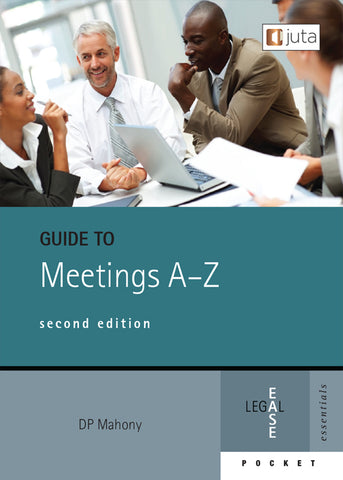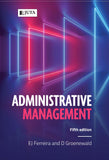
Guide to Meetings A-Z
About this publication
Guide to Meetings A-Z is a quick guide to the law, procedure and conduct of meetings, with entries arranged in alphabetical order. The author describes in ‘plain English’ the common-law principles attached to board meetings, and the implications of the Companies Act for shareholders’ and directors’ meetings, including acting outside of meetings.
Guide to Meetings A-Z provides company chairpersons and secretaries with the material they need to keep meetings on track and trouble-free. The publication is also a valuable source of reference for those who arrange and participate in meetings generally, highlighting the important issues that need to be clearly understood, from issuing the notice right through to recording the minutes.
Pat Mahony is a Fellow of the Chartered Governance Institute (CGI) and a past President of its Southern African division. He has also served on the International Council of the CGI. He was the group company secretary of two JSE-listed companies, a non-executive trustee of a major medical aid scheme, and the chairman and trustee of various pension and provident funds. After retiring he took a short-term contract as the CEO of the Mauritius Institute of Directors. He currently serves as a non-executive director of a non-profit company.
He has been involved in professional education and development for many years, and has lectured extensively in Southern Africa and other countries on subjects such as corporate governance, risk management, and the role of the company secretary.
About the Author:
Pat was a founding co-author (and later consulting editor) of South African Corporate Business Administration, published by Juta and regarded by many in the field as the definitive text on corporate secretaryship practice and procedure. He is the chief technical editor of Company Secretarial Practice, the successor to the aforementioned publication, also published by Juta. He has also published books on related subjects, including practical risk management, retirement fund governance and corporate governance in general, in addition to several highly influential best practice articles.
Pat’s reputation as a knowledgeable and dynamic presenter and author who conveys information in an easy and relaxed manner means that, in addition to his consultancy work, he is still very much in demand as a speaker at professional training events.
Content
Content
1. Adjournment
2. Agenda
3. Amendments
4. Annual General Meeting (AGM)
5. Apologies
6. Attendance of non-members
7. Attendance register
8. Business of a meeting
9. Chairman’s casting vote
10. Chairman’s election
11. Chairman’s powers and duties
12. Chairman and his role
13. Class meetings
14. Committees
15. Conflict of interest
16. Constitution
17. Counter motion
18. Court orders
19. Directors
20. Dissolution of meetings
21. Dropped motions
22. Electronic meetings
23. Executive powers
24. Expulsion from meetings
25. Formal motions
26. Matters arising from the minutes
27. Meetings
28. Members
29. Minutes
30. Motions
31. Motions to review and rescind
32. Non-members
33. Notices of meetings
34. Office bearers
35. Point of order
36. Poll
37. Postponement
38. Preparation for meetings
39. Preservation of order
40. Privileged occasions
41. Proposer
42. Proxies — companies
43. Proxies — bodies other than companies
44. Question before the meeting
45. Quorum
46. Record date
47. Representation at meetings
48. Requisitioned meetings
49. Resolutions — ordinary
50. Resolutions — special
51. Right of reply
52. Rules of debate
53. Scrutineers
54. Seconder
55. Secretary
56. Venue
57. Voting
58. Written resolutions of directors
59. Written resolutions of shareholders
60. ZATS
Index
Interest / Benefit to
- Company secretaries
- Chartered secretaries
- Chartered accountants
- Directors
- Managing agents of bodies corporate
- Committees of voluntary associations
- Lawyers
We Also Recommend





